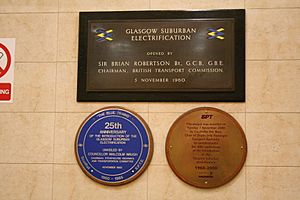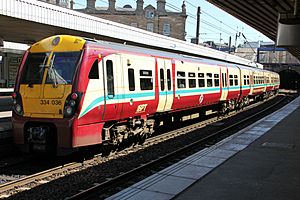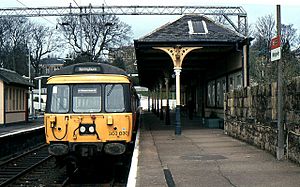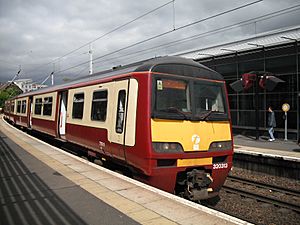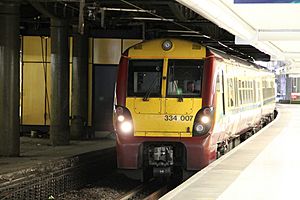North Clyde Line facts for kids
Quick facts for kids North Clyde Line |
|
|---|---|
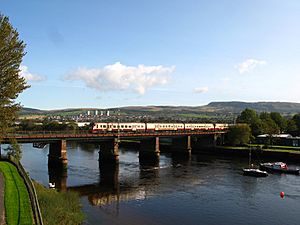
A Class 334 crosses the River Leven between Dumbarton Central and Dalreoch
|
|
| Overview | |
| Status | Operational |
| Owner | Network Rail |
| Locale | Glasgow Edinburgh Scotland |
| Termini | West Helensburgh Central Balloch Dalmuir Milngavie East Cumbernauld Airdrie Bathgate Edinburgh Waverley |
| Stations | 57 (including Cumbernauld line) |
| Service | |
| Type | Heavy rail |
| System | National Rail |
| Operator(s) | ScotRail |
| Rolling stock | Class 334 "Juniper" Class 320 Class 318 |
| Technical | |
| Number of tracks | Double track |
| Track gauge | 1,435 mm (4 ft 8 1⁄2 in) |
| Electrification | 25 kV 50 Hz AC |
| Operating speed | Max 90 mph (145 km/h) |
The North Clyde Line is a busy train route in West Central Scotland. It's like a main artery for trains in the area! ScotRail runs all the trains on this line. Thanks to some new connections, it's now one of four main train links between Scotland's two biggest cities, Glasgow and Edinburgh.
Contents
What is the North Clyde Line?
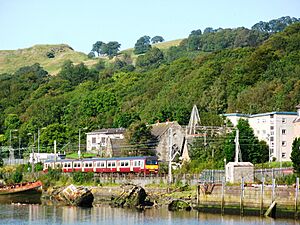
The North Clyde Line runs from east to west through the large city area of Glasgow. It connects places in northern Lanarkshire with western Dunbartonshire, going right through the city centre. This line was first set up with electric trains by British Rail in 1960. Later, in 2010, the line was made longer by Network Rail. It now reaches east from Airdrie to Bathgate, connecting with a line that goes all the way to Edinburgh.
Main Train Routes
The main part of the North Clyde Line goes from Edinburgh Waverley to Helensburgh Central. It passes through Bathgate and Glasgow Queen Street (Low Level). East of Glasgow city centre, there's a short branch line to Springburn. To the west, there are two different routes between Hyndland and Dalmuir. One goes through Singer and the other through Yoker. There are also branch lines that go to Milngavie and Balloch.
Some parts of the North Clyde Line are shared with other train services. For example, trains from the Argyle Line use the tracks from Partick to Dalmuir and Milngavie. Also, West Highland Line trains share the line between Westerton and Craigendoran. In the east, the line near Edinburgh Waverley is shared with trains going to Falkirk and Dunblane.
You can also change trains at many stations. At Glasgow Queen Street and Edinburgh Waverley, you can connect to other major lines. There are also links to the Cumbernauld Line at Springburn, the Maryhill Line at Anniesland, and the Glasgow Subway at Partick. Sometimes, freight trains also use parts of the North Clyde Line.
Tunnels in Glasgow
The line goes right through the middle of Glasgow. The main station in the city centre is Glasgow Queen Street (Low Level). A big part of the line in the city centre runs through tunnels. These tunnels are between High Street and the old Finnieston station. This underground section is the oldest railway tunnel in Glasgow, opened in 1886. It was built ten years before the Glasgow Subway.
How the North Clyde Line Grew
Building the Railway Lines
Like many train lines in Glasgow, the North Clyde Line wasn't built all at once. It's made up of many smaller lines from different railway companies that existed a long time ago. These companies were around during the Victorian era. Over time, these smaller lines were joined together to form the North Clyde Line we know today.
Here are some of the key parts that make up the line:
- 1842: The line from Haymarket to Newbridge Junction opened.
- 1846: The line from Edinburgh Waverley to Haymarket opened.
- 1849: The line from Newbridge Junction to Polkemmet Junction opened.
- 1850: The line from Dumbarton Central to Balloch Pier opened.
- 1858: Lines from Cowlairs to Bowling and Dalreoch to Helensburgh Central opened.
- 1862: The line from Polkemmet Junction to Coatbridge Sunnyside opened.
- 1863: The line from Westerton to Milngavie opened.
- 1870: Lines from Coatbridge Sunnyside to Bellgrove and Bellgrove to High Street Junction opened.
- 1871: The line from High Street Junction to College opened.
- 1874: Lines from Stobcross to Maryhill and Anniesland to Whiteinch opened.
- 1875: The line from Springburn to Bellgrove opened.
- 1882: The line from Jordanhill to Clydebank East opened.
- 1886: Lines from High Street to Stobcross, the Hyndland branch, and connections at Jordanhill and Anniesland opened.
- 1891: The line from Bowling to Dumbarton Central opened.
- 1892: The line from Bridgeton Central to High Street opened.
- 1897: The line from Clydebank to Dalmuir opened.
Most of these lines became part of the North British Railway. Later, in 1923, the North British Railway became part of the London and North Eastern Railway (LNER). Other parts of the line were owned by the Caledonian Railway, which became part of the London, Midland and Scottish Railway (LMS).
Line Closures and Re-openings
After 1948, all these lines came under the control of British Railways. Some lines were closed in the 1950s because they were no longer needed or didn't have enough passengers. Other lines closed later because they weren't chosen to be part of the new electric train system.
Here are some important closures:
- 1930: Manuel and Bathgate to Coatbridge Central.
- 1951: Whiteinch Victoria branch and the Kelvin Valley Line.
- 1959: Clydebank East station.
- 1960: Hyndland branch (a new Hyndland station opened on the main line).
- 1979: Bridgeton Central branch (replaced by Bridgeton on the Argyle Line).
- 1986: Balloch Central to Balloch Pier.
And here are some re-openings:
- 1986: Newbridge Junction to Bathgate (for passenger trains).
- 1989: Airdrie to Drumgelloch.
- 2010: Drumgelloch to Bathgate (for passenger trains).
Making the Line Electric
In 1960, most of the North Clyde train system became electric. This included lines from Airdrie, Springburn, and Bridgeton Central to Milngavie, Balloch Pier, and Helensburgh Central. After a special event on November 5, 1960, electric trains started running regularly on November 7.
A new connection was built near Bowling. This allowed North Clyde Line trains to use a different track through Dumbarton East. The old track from Dunglass to Dumbarton Central was then closed. The outer parts of the line were electrified with 25,000 volts (25 kV AC). The central area and some branch lines used 6,250 volts (6.25 kV AC) because of tight spaces in tunnels. As technology improved, these lower voltage lines were also changed to 25 kV.
In October 2010, the line between Bathgate and Airdrie also became electric. This was part of a big project called the Airdrie-Bathgate Rail Link. This meant that the line from Bathgate to Haymarket (near Edinburgh) was also electrified.
The Argyle Line Connection
Some old train lines in north-west Glasgow were closed to passengers and freight. However, a section from Rutherglen through Glasgow Central (Low Level) was reopened in 1979 as the Argyle Line. A new connection was built east of Partick to link the Argyle Line with the North Clyde Line.
The Bridgeton Central branch closed to passengers in 1979. It was replaced by the reopened Bridgeton Cross station on the Argyle Line. Also, in 1979, Partickhill station was replaced by the new Partick station. This new station makes it easy to connect with the Glasgow Subway.
Changes at Balloch Pier
In the 1980s, pleasure boat trips on Loch Lomond stopped. This led to the closure of Balloch Pier station in 1986. The Balloch train line was shortened even more in 1988. Balloch Central station was replaced by a new Balloch station across the road. This change helped get rid of a level crossing (where the road crosses the train tracks). The electric wires from the closed section to Balloch Pier were then used to reopen the line east of Airdrie to a new station at Drumgelloch in 1989.
The Airdrie–Bathgate Rail Link
Train services from Edinburgh to Airdrie stopped in 1956. But the line between Edinburgh and Bathgate was reopened for a trial in 1986 and was very popular. In 2005, the Scottish government decided to improve public transport between Glasgow and Edinburgh. This was to create a fourth direct train link between the two cities.
To do this, a closed section of the railway between Bathgate and the 1989 Drumgelloch station was reopened. The existing lines from Newbridge Junction to Bathgate and Drumgelloch to Airdrie were also improved. The whole line now has two tracks and is electric. Trains can go up to 90 miles per hour on this line.
The new link was approved in 2007, and work started in June 2007. The line opened for driver training in October 2010. Passenger services officially began on December 12, 2010.
The Cumbernauld Line
As part of a bigger project called the Edinburgh to Glasgow Improvement Programme (EGIP), plans were made to electrify the Cumbernauld Line. This would create an electric link between the Springburn branch of the North Clyde Line and the Cumbernauld Line. This meant electric trains could run from Cumbernauld into the Low Level of Glasgow Queen Street. This connected Cumbernauld to places west of Glasgow and also freed up space on the High Level lines out of Queen Street.
Work on these improvements started in 2013. From May 2014, electric trains began running between Balloch/Dalmuir and Cumbernauld. These trains used Class 318, 320, and 334 models. After the EGIP project was finished, new electric trains (Class 385 units) started running directly from Glasgow Queen Street High Level to Edinburgh Waverley via Cumbernauld.
How Often Do Trains Run?
Weekday and Saturday Off-Peak Times
- Two trains per hour (2tph) go from Helensburgh Central to Edinburgh.
- Two trains per hour (2tph) go from Balloch to Airdrie (via Singer).
- Two trains per hour (2tph) go from Milngavie to Springburn.
- Argyle Line trains run every 30 minutes from Glasgow Central (Low Level) to Milngavie, Dalmuir (via Yoker), and Dalmuir (via Singer).
Sunday Services
- Two trains per hour (2tph) go from Helensburgh Central to Edinburgh (via Singer).
- One train per hour (1tph) goes from Partick to Cumbernauld.
- Argyle Line trains run every 30 minutes from Glasgow Central (Low Level) to Balloch (via Yoker) and Milngavie.
What Trains Are Used?
Old Trains
Before the line became electric, trains were mainly pulled by steam engines. When the line became electric in 1960, new electric trains called Class 303 EMUs were introduced. These trains were built locally. From 1967, similar Class 311 EMUs also started running on the line.
The Class 303 and 311 trains were known as the "Blue Trains" because they were painted bright blue in the 1960s. Later, they were repainted in different colours, including the orange and black colours of Strathclyde Passenger Transport.
In the 1970s, a new train depot was built south of the Clyde. This depot took over the maintenance of electric trains. In 1979, when the Argyle Line reopened, Class 314 EMUs were introduced. These were mostly used on the Argyle Line, but sometimes on the North Clyde Line too.
In 1990, newer Class 320 EMUs started to replace the older Class 303 trains. A few Class 303 units continued to run until December 2002, when they were finally taken out of service. They were replaced by Class 334 "Juniper" EMUs and Class 318 units.
Current Trains
Today, Class 334 trains run services to Edinburgh via Bathgate. They also run some North Clyde Line services. Most North Clyde Line and Argyle Line services are operated by Class 320 and Class 318 trains. Class 318s and Class 320s are not allowed to run east of Airdrie because they don't have special cameras for the driver to check the doors. The Class 334 trains do have these cameras.
Future Plans
Crossrail Glasgow
Many passengers travelling through Glasgow city centre have to walk or take a bus between Central and Queen Street stations. To make things easier, there's a long-term idea to build a direct train link. This link would connect the North Clyde system with the lines that start from Glasgow Central (High Level). This would allow direct trains from places like Renfrewshire and Ayrshire to go to Glasgow Queen Street (Low Level). It would also create new cross-city services, like Airdrie to Paisley.
This plan would involve reopening a freight-only line and building a new curve. It would also allow trains from other areas to use this new Crossrail link. However, money for this project has not been found yet, so it's still just a future idea.
Train Accidents
- On September 11, 1986, two railway workers died in a crash between two trains at Bridgeton Central.
- On March 6, 1989, two people died when two trains crashed head-on at Bellgrove.
Images for kids


